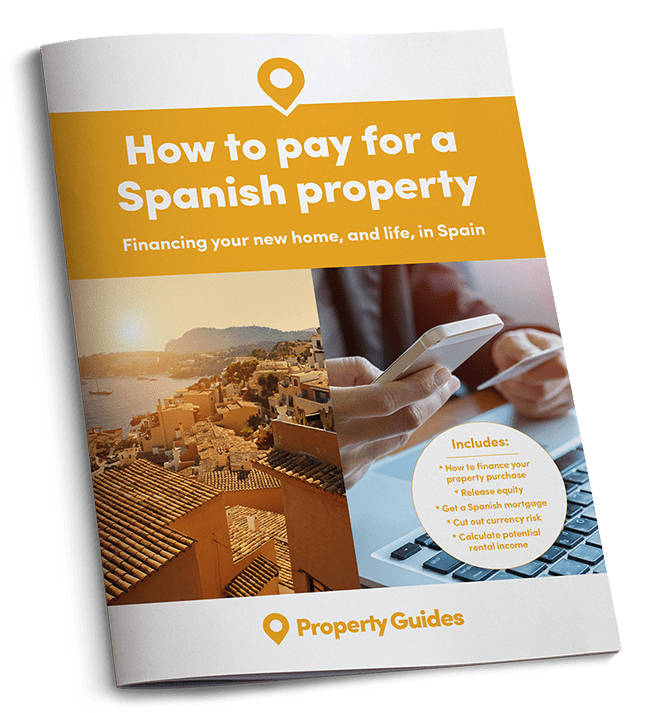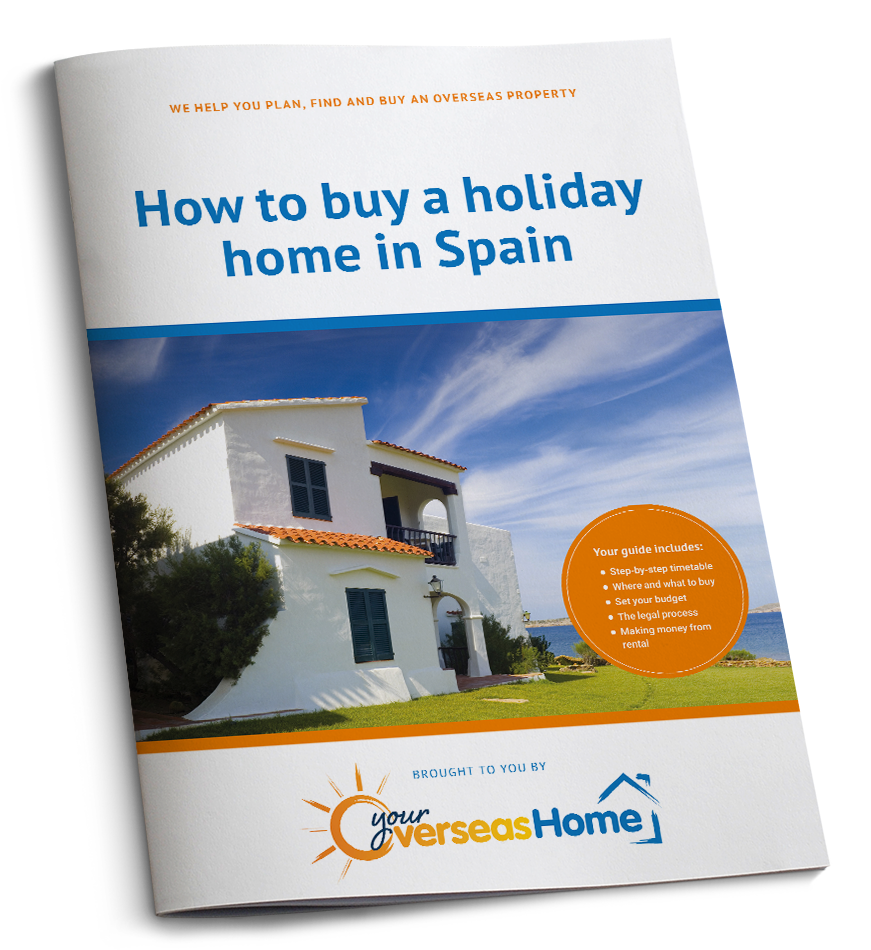Spain’s third-biggest city has a lot going for it – and overseas buyers are catching on fast. Could you join them? Well, how does year-round sun, all the conveniences of urban living plus proximity to the beach, delicious food and a low cost of living sound? And if you’re looking for authentic Spain, then Valencia’s rich culture and heritage is just the ticket.
Why move to Valencia?
Spain’s third biggest city has a lot going for it, and people from around the world are catching on fast. As well as being close to the beach and just a two-hour flight away from the UK, Valencia is the birthplace of paella and home to the Holy Grail, the best oranges in the world, and a month-long festival of fireworks called Fallas. Valencia’s combination of superb weather, low cost living, proximity to nature and interesting culture makes it an excellent choice for those moving to Spain.
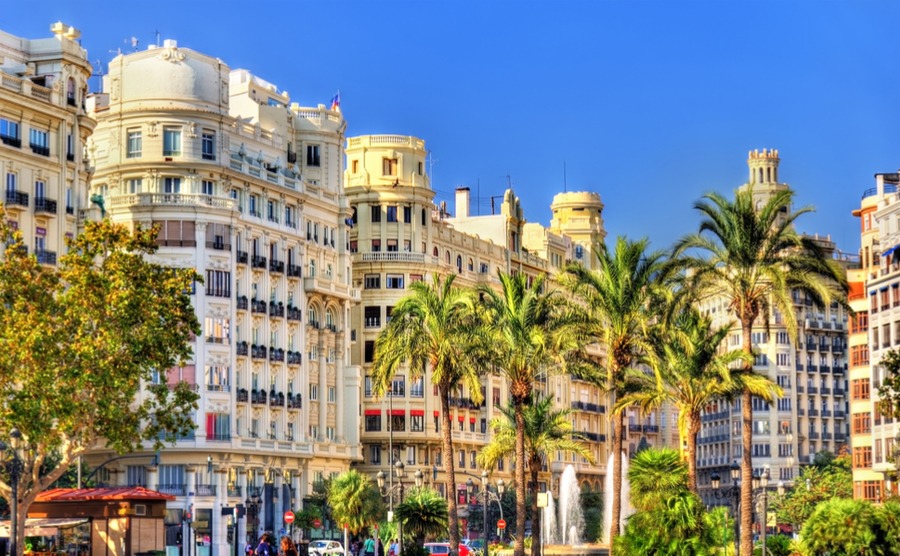
Valencia is Spain’s largest city and combines the beach lifestyle with all the convenience of urban living.
What’s the climate like?
Despite being a cosmopolitan city of more than 800,000 people, the slower pace of life forces you to relax. Of course, the warmer weather plays a role in this – Valencia’s climate is positively idyllic, with blue skies and sunshine to die for, even when it’s supposedly ‘winter’. In fact, winters are so mild, you could almost mistake them for English summers – although you’ll certainly need a coat when the sun goes down. In January, the coldest month of the year, the average day time temperature is between 14-20ºC, and at night between 4-12ºC.
Don’t miss your free tickets to Your Overseas Home while they last. It’s the leading property show dedicated solely to helping serious buyers get detailed answers to their questions from estate agents, lawyers, financial and currency experts, removals specialists and more.
Summer in the city technically lasts for eight months of the year, from April to November – although it’s not uncommon to experience temperatures of 24-28 in February and March. Valencia’s climate is classified as sub-tropical. During the day, the average temperature is 23 degrees and 13.8 degrees at night. In August, the hottest month, you won’t want to be far from a fan. The average temperature ranges from 28-34 degrees in the day, and around 22 degrees at night. Living in Valencia means enjoying 2,660 sunshine hours per year.
It occasionally rains, and when it does, it pours, sometimes lasting for days at a time. However, in a way, we do look forward to it, as it’s a rarity! September gets a lot of rain, but often they are just quick showers that help clear the humidity.
SEARCH for your home in Valencia
Where are the best beaches?
The main beaches in the city are El-Cabanal, Las Arenas and Malvarossa, all of which have Blue Flag status, as well as El Saler to the south inside the Albufera Natural Park. If you’re in the city, you can be at the beach within 20-30 minutes, either on a bike or via tram. It’s warm enough to swim from March onwards. In summer, the average temperature of the water is a decidedly bath-like 26 degrees.
Don’t put off your dream of a home in the sun with legal worries – find out how to structure your purchase, get residency and plan inheritance with a trusted solicitor today.
As it’s the Mediterranean, waters are calm – although it’s possible to surf and kite-surf at certain times. If these are your sports of choice, just a short drive away down towards Dénia you’ll discover plenty of great surf spots.
What activities can you do in Valencia?
Valencia is a sports-mad city. Valencia Football Club plays at Mestalla Stadium in the centre of the city, and when it’s game day, people take to the streets in solidarity. The city is also completely flat, which makes it excellent for cycling. The city’s cycle lanes are extensive, and there is an affordable bike hire system, Valenbisi, which costs just £30 per year and allows you to grab and drop off a bike whenever you like. The mountainous countryside surrounding Valencia is perfect for more serious cyclists, as well as hikers and rock climbers. Furthermore, you can ski just two hours from the city!
Being flat, Valencia is also a city for runners. It seems that almost every weekend there is a long distance run of some kind, culminating in the Valencia Marathon in December, which is the fastest marathon in Spain. There are also triathlons, Iron Men, Ocean Swims and more happening every weekend – often around the vibrant port area of the city.
A major hub of activity, both sporting and social, is the Turia Park, which runs for 9km from The City of Arts and Sciences, all the way to the BioPark – an eco-friendly zoo. This sunken park was once the course of the Turia River, but after catastrophic floods in 1957 the river was diverted and the empty riverbed was converted into this park. Every sport you can imagine is played here, even cricket!
There’s a baseball diamond, basketball courts, skate parks, cycle lanes, tennis courts, hockey, football, table tennis, climbing walls, and a cushioned running loop that runs the whole length of the park. You have cafés dotted throughout, so you don’t have to wander far to get a café con leche or a cold beer. There is also Gulliver’s Park – a children’s adventure playground, as well as the Valencian Music Palace, a spectacular live music venue.
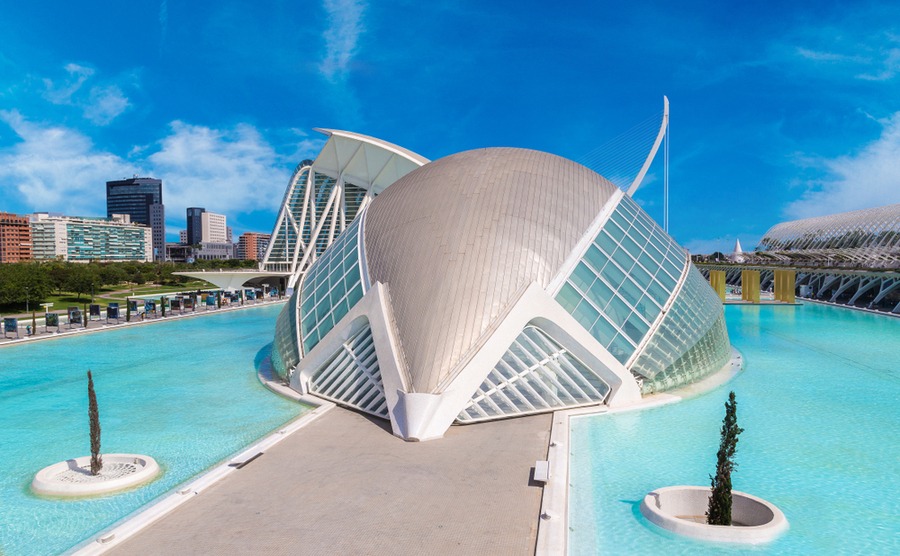
The City of Arts and Science is one of the ‘Twelve Treasures of Spain’. S-F / Shutterstock.com
The City of Arts and Sciences, named as one of the ‘Twelve Treasures of Spain’, is the most important modern tourist destination in Valencia. As well as being an astounding architectural feat, the futuristic complex offers lots to do – there’s an IMAX cinema, science museum, open-air aquarium, an opera house, and landscaped gardens.
What’s the food like?
Paella is of course the favourite dish, given paella rice originates from nearby Albufera National Park, around half an hour south of the city (just €1.50 on the bus). Fideuá is also popular, which is very similar to paella but with noodles instead of rice. Seafood is of course top notch – all restaurants serve standard Spanish staples of calamari, garlic prawns, mussels and clams.
As for drinks, you must try Agua de Valencia – a strong local favourite made from vodka, gin, local cava and freshly squeezed Valencian orange juice. Also, the nearby Martes mountain range is home to a number of excellent wineries – so be sure to sample wines from that region.
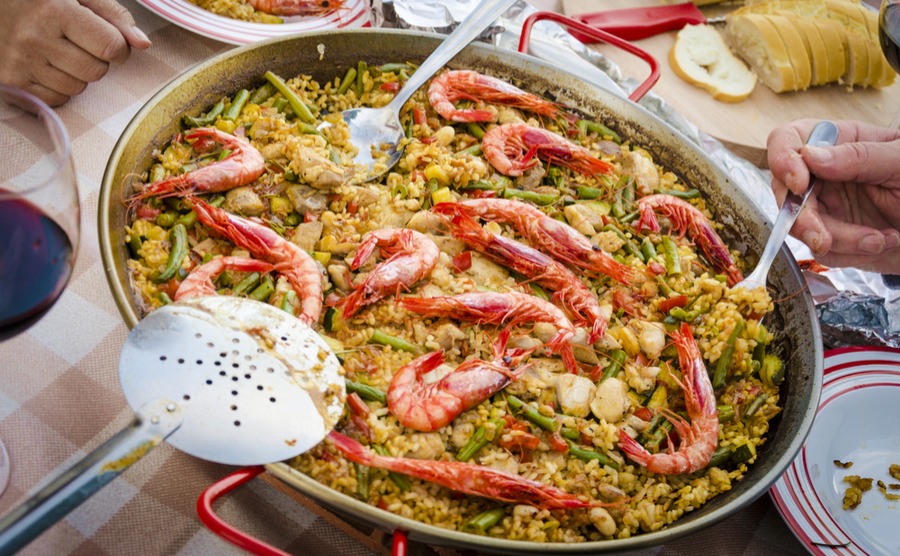
The paella in Valencia is of course delicious – it is the homeland of Spain’s most famous dish, after all!
How easy is getting to Valencia?
Both Easyjet and Ryanair fly into Valencia airport, which makes it possible to get a return flight from between £60-70. Additionally, Madrid is a two-hour fast train away, as is Alicante. Barcelona is three hours away. While Valencia is small enough to navigate entirely on foot, or by bike, the Metro system is cheap and easy to navigate with five lines connecting the city to surrounding towns.
What’s the cost of living in Valencia?
One of the major factors attracting expats to Valencia when they move to Spain is the lower cost of living. According to Numbeo, rent in London is 263.77 percent higher than in Valencia. A three-bed apartment in the heart of the city will cost €988 (£847) per month, or in the suburbs €662 (£567).
Furthermore, a monthly public transport ticket will set you back €40 (£34) rather than the UK average of £140. A beer will cost €2 (£1.70), a wine €3 (£2.57), and a three-course dinner for two shouldn’t be more than €30 (£26), as long as you’re dining somewhere local rather than in the tourist hotspots down by the beach or in El Carmen (the Old Town).
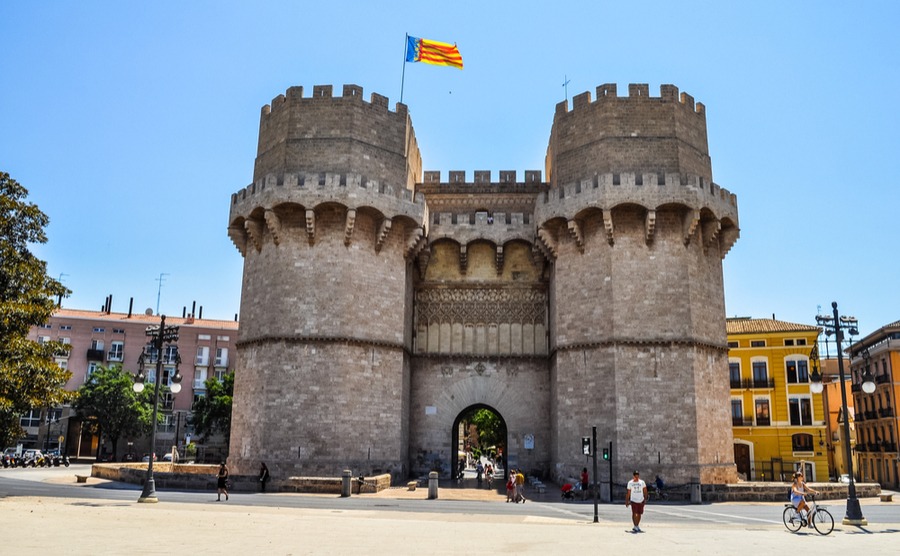
Valencia is eminently affordable compared to similar cities (or even smaller towns!). s74 / Shutterstock.com
What’s Valencia like for retirees?
Great weather, healthy lifestyle, cheap cost of living, cheap public transport and easy (and cheap, again!) access back to UK are the main factors attracting retirees. Additionally, healthcare is excellent and affordable. A trip to the doctor costs around €35 (£30). Unlike other retiree hotspots, Brits haven’t entirely overrun Valencia just yet. While people speak English and there are established expat groups and plenty of ways to make British friends, Valencia remains very Spanish. This is an ideal spot if you want to learn the language and really immerse yourself in the Spanish way of life.
Find your perfect home for your new life in Spain on our property portal.
Patacona
Port Saplaya
Betera
Lliria
Olocau
Requena
Utiel
Popular areas
If you want to spend your days by the beach, living in Patacona or El-Cabanal will mean having the ocean (and the city) on your doorstep – plus, there are bargain properties to be found. Another popular area is Port Saplaya just north of the city, referred to as Valencia’s ‘Little Venice’. For something a little further out of town, consider one of the towns nestled in the foothills of the Calderona Mountains – Betera, Lliria and Olocau are all beautiful. If you head west from the city, things get more rural, and cheaper! While there aren’t as many expats out in towns like Requena and Utiel, there is great food and wine and spectacular countryside.
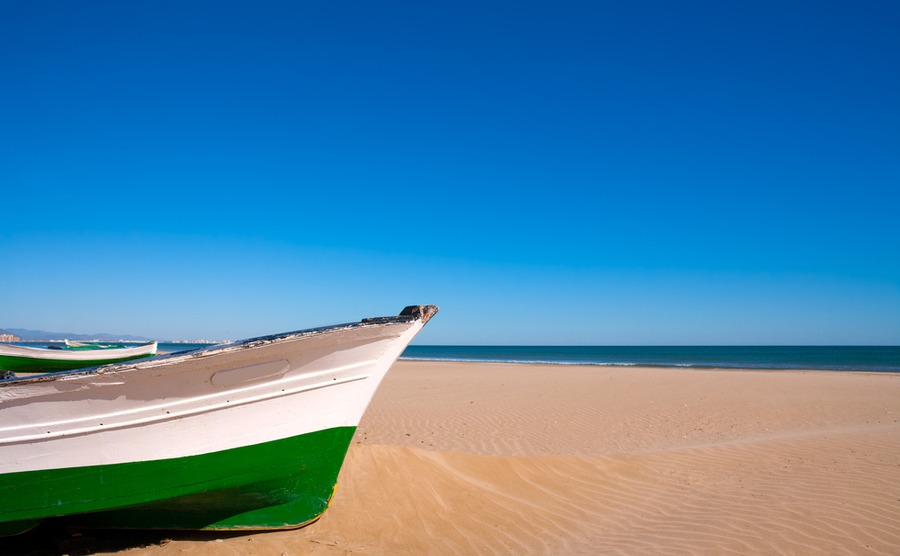
Imagine having this on your doorstep! Live in Patacona and you would.
What will you pay?
You can buy a three-bed apartment at the beach in Patacona from around €239,000. In Port Saplaya, four-bed apartments start from €220,000 and four-bed houses from €360,000. Out near Lliria, you can buy a five-bedroom private villa with pool from €145,000.
You could double or even triple your buying power by purchasing jointly with relatives or friends. Find out more in our Guide to Buying Abroad with Family!
What’s Valencia like for working people?
A lot of those moving to Valencia are digital nomads, which means they work remotely and entirely online. According to the World Travel Guide, Valencia is the seventh best city in the world for digital nomads. Not only is the wifi far faster than the UK, but it’s possible to rent or buy very cheaply in the outer suburbs, and still be close enough to commute into town in under 30 minutes.
Furthermore, it’s still possible to snap up a seafront apartment for €1,200 (£1,028) per month. Additionally, a lot of younger people moving to Valencia do so to teach English. While it is possible to find full-time employment in Valencia itself, you will most likely need a good grasp of Spanish, and possibly Valencian.
El Carmen
Ruzafa
Benimaclet
El-Cabanyal
Patraix
Popular areas
The most popular areas with young professionals and renters are El Carmen, Ruzafa, Benimaclet, El-Cabanyal and Patraix. Ruzafa is very central but retains a lovely villagey-vibe, and is probably the ‘hippest’ part of the city. It’s home to many of the best bars, restaurants and shops, a number of popular co-working spaces and lots of affordable apartments.
Benimaclet is a touch scruffier, but the community-feel is a winner. Here you’ll find students, young professionals and young families hanging out together in the many restaurants, cafes or local events. You can find live music in Benimaclet every night of the week – it’s an exciting part of town. El-Cabanyal may be a little rough around the edges, but more and more people are making the move out of the city and down to the beachside suburb. Not only is it cheaper to rent, but new bars, business, restaurants and markets are popping up all the time. You heard it here first!
How much will you pay?
If you’re willing to share with others, you could rent for as little as €200 per month in Benimaclet or El-Cabanyal. Bills do push things up – expect to pay an additional €60 in bills each month. If you want your own place, in Benimaclet a three-bed starts from €600 per month for something basic. In El Carmen, expect to pay €800 for a two-bed. For something nice in Ruzafa, expect to pay €1,000 per month for a two-bed.
What’s Valencia like for holiday home buyers?
If you want to buy property in Spain to use as a holiday home, the city of Valencia has some great options. Properties are being snapped up fast to be used as Airbnbs. Valencia has changed a lot over the last few years, and the tourists are flooding in. In fact, you often hear people referring to the city as the ‘new Barcelona’. If you want to buy a property to rent out when you’re not in town – buying in El Carmen, Ruzafa or Canovas is the best choice for tourist footfall, although, El-Cabanyal is catching up in the Airbnb department too.
Ruzafa
El-Cabanyal
Gandia
Oliva
Canovas
Popular areas
Outside of the city, the Southern Valencia region is the perfect place to buy a country retreat amongst the orange groves, or in the mountains. There are an abundance of bargain properties, villas with pools or properties with land to be found within half an hour to 40 minutes’ drive from the city centre, or further south in beautiful locations like Gandia, Oliva, Dénia and Xabia.
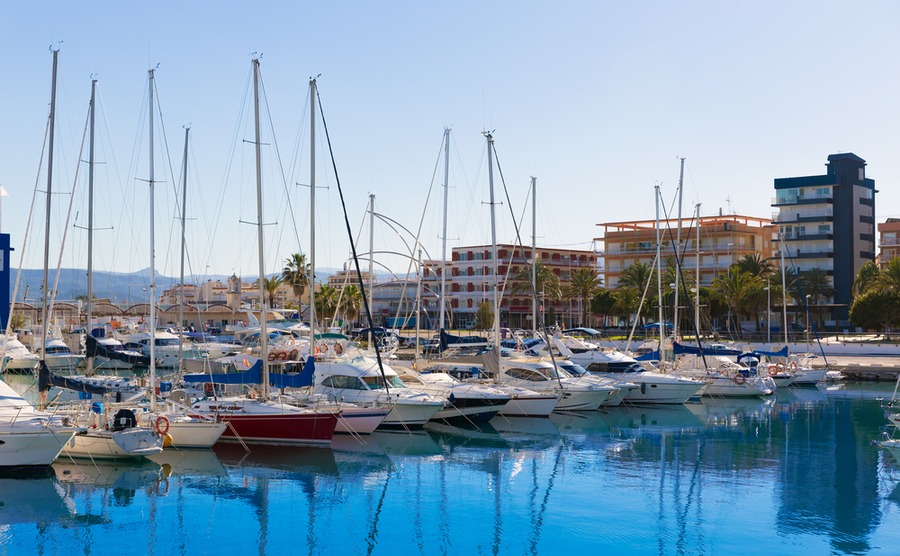
Further south, areas like Gandia are particularly popular among overseas buyers.
How much will you pay?
It’s possible to buy a two-bed apartment in Ruzafa from €140,000, but prices are going up fast. For something move in ready and fully refurbished, expect to pay closer to €195,000 (£167,000) upwards.
Don’t get caught when discussing your price – read our insider tips and tricks in How to Negotiate Abroad.
El-Cabanyal is far cheaper. For example, if you were looking for a real fixer-upper – you could find a six bed, detached house for around €210,000. Apartments start from as little at €80,000 and zoom right up to €500,000 for something incredibly swanky.
Down in Gandia and Oliva apartments start from €80,000. In the countryside, you can find three-five bedroom houses starting from €134,950.
Buying a home in Valencia
If you’re buying a home in Valencia, the first thing to do is to work out your budget. There’s any number of out of date, unclear articles out there on the internet – but we’ve put together a comprehensive financial guide to all aspects of purchasing in Spain. Get your copy below for free and start your purchase today!
